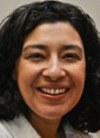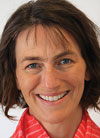 Melissa Glenn — Colby College研究集中在有助于认知和情绪行为的神经系统的协调功能是如何在精神疾病中失调的,以及它们是否可以通过营养维持物质得到增强和保护。关注必需的营养胆碱,他们是神经递质乙酰胆碱的前体。胆碱是发育中的一种有效的表观遗传因子,它在围产期的对神经组织和行为的可用性、改变动物对环境的反应有直接的影响。并导致注意力、记忆和情感方面的终身增强
Melissa Glenn — Colby College研究集中在有助于认知和情绪行为的神经系统的协调功能是如何在精神疾病中失调的,以及它们是否可以通过营养维持物质得到增强和保护。关注必需的营养胆碱,他们是神经递质乙酰胆碱的前体。胆碱是发育中的一种有效的表观遗传因子,它在围产期的对神经组织和行为的可用性、改变动物对环境的反应有直接的影响。并导致注意力、记忆和情感方面的终身增强 Paula Niedanthal — University of Wisconsin威斯康星大学麦迪逊分校我最近的研究旨在揭示情绪表达和沟通的文化起源,并解释世界各地的情绪误解。理论依据取决于长期历史迁移的异质性与同质性的概念,这些概念是根据某一国家或地区殖民化(约500年前)开始之对当前人口的贡献而定义。在一个社会中,迁徙史应该影响社会中面部表情的形式和功能,因为实质性的迁移和最小的迁移对一个国家的沟通和行为预测构成了迥然不同的社会挑战。初步的实证结果支持了这种预期:我们首先表明,高异质性国家的个人与历史上同质国家的个体相比,显示了有利于情绪表达的规则
Paula Niedanthal — University of Wisconsin威斯康星大学麦迪逊分校我最近的研究旨在揭示情绪表达和沟通的文化起源,并解释世界各地的情绪误解。理论依据取决于长期历史迁移的异质性与同质性的概念,这些概念是根据某一国家或地区殖民化(约500年前)开始之对当前人口的贡献而定义。在一个社会中,迁徙史应该影响社会中面部表情的形式和功能,因为实质性的迁移和最小的迁移对一个国家的沟通和行为预测构成了迥然不同的社会挑战。初步的实证结果支持了这种预期:我们首先表明,高异质性国家的个人与历史上同质国家的个体相比,显示了有利于情绪表达的规则 Koraly Perez-Edgar宾夕法尼亚州立大学心理学副教授,研究领域为,气质和精神病理学的关系。具有极端气质特征的行为抑制和害羞儿童社交焦虑的风险增加。注意机制的个体差异在改善或加剧这些潜在的脆弱性方面可能起着重要的作用。她的下一个项目将研究生命的头两年中对威胁的关注,并利用移动眼动跟踪技术观察幼儿的社会行为。
Koraly Perez-Edgar宾夕法尼亚州立大学心理学副教授,研究领域为,气质和精神病理学的关系。具有极端气质特征的行为抑制和害羞儿童社交焦虑的风险增加。注意机制的个体差异在改善或加剧这些潜在的脆弱性方面可能起着重要的作用。她的下一个项目将研究生命的头两年中对威胁的关注,并利用移动眼动跟踪技术观察幼儿的社会行为。 Barbara L. Fredrickson北卡罗来纳大学教堂山分校商学院的杰出心理学教授、积极情绪与心理生理学实验室主任。荣获2016~2017年度詹姆斯卡特奖。她是积极心理学研究领域的领军人物,积极心理学之父马丁•塞利格曼评价她是“积极心理学领域的天才”。中文译著有《积极力》、《积极情绪的力量》、《爱的方法》。
Barbara L. Fredrickson北卡罗来纳大学教堂山分校商学院的杰出心理学教授、积极情绪与心理生理学实验室主任。荣获2016~2017年度詹姆斯卡特奖。她是积极心理学研究领域的领军人物,积极心理学之父马丁•塞利格曼评价她是“积极心理学领域的天才”。中文译著有《积极力》、《积极情绪的力量》、《爱的方法》。 Aaron S. Benjamin
Aaron S. Benjamin
University of Illinois at Urbana-Champaign
Despite the fact that research into the cognitive processes and procedures underlying eyewitness identification has a history nearly as old as that of empirical research on memory more generally, there has been a surprising — and unfortunate — lack of cross-fertilization between the two domains. This set of circumstances has had negative repercussions for both fields: Laboratory researchers concerned with basic problems of human memory often overlook important societal problems that should play a role in shaping agendas for basic research, and applied researchers often failed to consider basic principles of human learning and memory in drawing conclusions from their own work. Many of the failures of generalizability and reliability identified in a recent National Academy of Sciences report,Identifying the Culprit: Assessing Eyewitness Identification, can be partially traced back to this artificial division between applied and theoretical work on human memory.
The goal of research in my lab at the University of Illinois is to bring basic empirical and computational research on human learning, memory, and decision-making to bear on applied problems. From our perspective, the research that has the most applied potential is not necessarily the work that bears the most superficial similarity to the real-world situation to which it is being applied. Rather, it is the work that has the greatest potential to generalize to a wide range of situations and circumstances, including the real-world scenarios that inspire that work. During my sabbatical, I will be developing a program of research on eyewitness memory — a new domain of interest in my lab.
In recent years, we have tried to bridge the gap between applied and basic research on problems related to the effects of aging on memory, to the design of educational techniques and technology, to the development of training regimens for skill learning, and to the question of how faces are recognized. Within eyewitness-memory research, we have begun programs related to the following four basic questions that we see as central to advancing the field:
1. Memory:What are the basic cognitive processes by which an eyewitness chooses a suspect out of a lineup?
2. Individual differences:What are the individual differences that reveal something about whether a given eyewitness’s identification is likely to be accurate or not?
3. Metamemory:What information can an eyewitness report about the accuracy of his or her own identification judgments?
4. Identification algorithms:How can we develop a more multidimensional assessment procedure for suspect identification and use that rich data set, in conjunction with statistical learning techniques, to develop algorithms that bear on the accuracy of an identification decision?
I will spend my sabbatical at the University of California, Irvine, which has one of the world’s best programs in mathematical psychology and cognitive science, as well as in psychology and law. I hope to collaborate with people who share interests in learning and memory and who can bring a new set of tools to our burgeoning program in eyewitness memory.
 Rachel F. Barr
Rachel F. Barr
乔治城大学发展心理学家蕾切尔·巴尔 Rachel F. Barr是一位发展心理学家,他的研究重点是了解婴儿期发育的学习和记忆机制。因为婴儿的语言技巧依靠模仿和学习的方法来找出婴儿已经学会了什么,以及他们怎样记住它,又记住了多久。研究的重点是婴儿如何从不同的来源、电视、兄弟姐妹、成人和不同的环境中获取信息。最近,在乔治敦早期学习项目研究可能提高电视学习婴儿因素。
I am a developmental psychologist specializing in early sociocognitive development. Urie Bronfenbrenner, a major theorist in the field of developmental science, is the major influence on my research program, which investigates how three key environmental contexts (digital, linguistic, and parental) influence early learning trajectories. I use converging methods by directly measuring social learning in young children via deferred imitation methods, quantifying the quality of parent–child interactions via observational methods, and augmenting these approaches using survey data. During my sabbatical, I will be working on three interrelated projects:
1. Digital context:Before the launch of the iPad in April 2010, reading and watching television were the major daily childhood media-related activities that were investigated in the field. The iPad launch was immediately followed by a rapid and unregulated release of more than 80,000 “educational” tablet applications. Across the past 15 years, I have compared how infants encode and process information from live interactions, television, books, and touch screens/tablets. Despite progress in understanding the role of content and context in early childhood learning from digital media, the rapid expansion of digital technology means that current assessments of household media use are likely incomplete. During my sabbatical, I will form a collaborative network to improve media-assessment protocols and examine the underlying neural mechanisms of learning in the digital age. I also will devote time to learning the fundamentals of two new, cutting-edge techniques — eye-gaze contingency eye-tracking and functional near-infrared spectroscopy.
2. Linguistic context:Two-thirds of the world’s children are raised in homes where multiple languages are spoken. Bilingual children show heightened cognitive flexibility, defined as the ability to adjust their behaviors in response to changes in task demands and the ability to inhibit their attention to irrelevant information. For example, bilingual children can more easily switch between activities and see information from different perspectives than monolingual children can. Recently, my colleagues and I have demonstrated that bilingual infants also show earlier memory flexibility than do monolinguals. I will examine whether these differences in memory processing during infancy predict bilingual children’s cognitive flexibility later in childhood. A better understanding of the consequences of early bilingualism on cognitive outcomes will allow early educators to develop pedagogical strategies to capitalize on the protective cognitive strengths of bilingualism. These strategies could be generalized to other children by focusing on the cognitive strengths of each child.
3. Parenting context:Bronfenbrenner famously once said, “If you want to understand something, try to change it.” In my third project, I will continue to test the Just Beginning “Baby Elmo” program. This program uses a dual-generation and media-based approach to parenting education, working with fathers and their young children over the course of five lessons to enhance the quality of the father–child relationship. Each lesson incorporates “Sesame Beginnings” videos into a training session with the father followed by structured play time that allows the father to practice concepts from the lesson with his child. It has been implemented primarily with incarcerated teen fathers of young children (ages 0–3). During my sabbatical, my collaborators and I will begin to assess the longer-term effects of program inclusion and adapt it for broader use in community settings.
 Peter C. Gordon 彼得·格登 哥伦比亚大学神经科学与教育专业负责人,发展语言学家。 研究领域包括使用计算机从数据中提取有用信息建模与模式识别电气工程和计算机科学。采取措施将计算机模型方法纳入到他的心理学研究。
Peter C. Gordon 彼得·格登 哥伦比亚大学神经科学与教育专业负责人,发展语言学家。 研究领域包括使用计算机从数据中提取有用信息建模与模式识别电气工程和计算机科学。采取措施将计算机模型方法纳入到他的心理学研究。 Lori L Holt 洛里 L 霍尔特,卡耐基梅隆大学心理学教授,霍尔特在促进人们对涉及人类对口头语言感知的基本认知过程的理解方面做出了杰出贡献。Holt博士是听觉认知神经科学的专家,专注于理解人类如何解释口语的复杂性。她的研究计划基于一般的、而不是唯一的人类或语音特定机制的人类语音识别。她的训练包括听力的单一单元的电生理学和动物行为模型,尤其是人类行为方式的跨越发展。
Lori L Holt 洛里 L 霍尔特,卡耐基梅隆大学心理学教授,霍尔特在促进人们对涉及人类对口头语言感知的基本认知过程的理解方面做出了杰出贡献。Holt博士是听觉认知神经科学的专家,专注于理解人类如何解释口语的复杂性。她的研究计划基于一般的、而不是唯一的人类或语音特定机制的人类语音识别。她的训练包括听力的单一单元的电生理学和动物行为模型,尤其是人类行为方式的跨越发展。 Greg Hajcak纽约州立大学石溪分校临床心理学家。研究领域为,情绪和认知心理生理学方法;焦虑症及其治疗。利用一系列心理生理学和神经生物学的措施(即,事件相关脑电位或EPRs事件相关电位、功能性磁共振成像FMRi,惊跳反射、瞳孔、眼球追踪、心率、皮肤电导)了解认知,情感,和精神病理学。我的一些工作基于自然-意愿来澄清情绪认知相互作用的测量和关键机制
Greg Hajcak纽约州立大学石溪分校临床心理学家。研究领域为,情绪和认知心理生理学方法;焦虑症及其治疗。利用一系列心理生理学和神经生物学的措施(即,事件相关脑电位或EPRs事件相关电位、功能性磁共振成像FMRi,惊跳反射、瞳孔、眼球追踪、心率、皮肤电导)了解认知,情感,和精神病理学。我的一些工作基于自然-意愿来澄清情绪认知相互作用的测量和关键机制 Ara Norenzayan 阿兰•洛伦萨杨加拿大不列颠哥伦比亚大学心理学家,究方向为宗教思想和行为的演化和认知起源。宗教思想和行为,文化变迁和人类心理和普遍性的文化进化问题。
Ara Norenzayan 阿兰•洛伦萨杨加拿大不列颠哥伦比亚大学心理学家,究方向为宗教思想和行为的演化和认知起源。宗教思想和行为,文化变迁和人类心理和普遍性的文化进化问题。 艾奥妮•法恩 Ione Fine 华盛顿大学心理学系,她的研究专注于视觉系统的可塑性,包括在成年期的知觉学习的研究以及由于失明或失聪导致的神经重组,在过去几年里,他的实验室重点已经放在了长期视觉剥夺对人类视觉处理的影响,包括长期失明和视力恢复对大脑的影响。
艾奥妮•法恩 Ione Fine 华盛顿大学心理学系,她的研究专注于视觉系统的可塑性,包括在成年期的知觉学习的研究以及由于失明或失聪导致的神经重组,在过去几年里,他的实验室重点已经放在了长期视觉剥夺对人类视觉处理的影响,包括长期失明和视力恢复对大脑的影响。 Todd A. Kahan 托德·卡汗贝茨学院心理学系,探讨了注意力的交互角色,知觉,记忆,和视觉感知的字词阅读。他的研究考察了注意的机制,感知,我们每天遇到的无法估量的视觉和记忆信息的数量。
Todd A. Kahan 托德·卡汗贝茨学院心理学系,探讨了注意力的交互角色,知觉,记忆,和视觉感知的字词阅读。他的研究考察了注意的机制,感知,我们每天遇到的无法估量的视觉和记忆信息的数量。2013-2014
 Marie Banich科罗拉多大学波尔得分校心理学和神经科学教授
Marie Banich科罗拉多大学波尔得分校心理学和神经科学教授 Stephen G. Lomber史蒂芬·隆姆博 University of Western Ontario
Stephen G. Lomber史蒂芬·隆姆博 University of Western Ontario  Kevin Wilson Gettysburg College
Kevin Wilson Gettysburg College2012-2013
 Dr. Liisa Galea伽利雅 -- University of British Columbia
Dr. Liisa Galea伽利雅 -- University of British Columbia Dr. Cheryl Kaiser -- University of Washington
Dr. Cheryl Kaiser -- University of Washington Dr. Martin Sarter -- University of Michigan
Dr. Martin Sarter -- University of Michigan Dr. Helen Tager-Flusberg -- Boston University 认知神经科学发展 孤独症
Dr. Helen Tager-Flusberg -- Boston University 认知神经科学发展 孤独症
2011-2012
 Patrick Davies -- University of Rochester
Patrick Davies -- University of Rochester Craig Enders -- Arizona State University
Craig Enders -- Arizona State University Pamela Hunt -- College of William and Mary
Pamela Hunt -- College of William and Mary2010-2011

Alison Gopnik 艾莉森·高普妮克 — University of California, Berkeley
 Doug Medin 道格拉斯·梅丁— Northwestern University
Doug Medin 道格拉斯·梅丁— Northwestern University2009-2010
 Jeansok Kim金镇—University of Washington
Jeansok Kim金镇—University of Washington2008-2009
 Turhan Canli图尔汉·坎利 — Stony Brook University
Turhan Canli图尔汉·坎利 — Stony Brook University Terrence Deak 特伦斯·迪克 — State University of New York – Binghamton
Terrence Deak 特伦斯·迪克 — State University of New York – Binghamton Sharon Thompson-Schill 汤普森·希尔— University of Pennsylvania
Sharon Thompson-Schill 汤普森·希尔— University of Pennsylvania2007-2008
 Lisa Feldman Barrett 莉莎·费德曼·巴瑞特— Boston College
Lisa Feldman Barrett 莉莎·费德曼·巴瑞特— Boston College Susan Gelman 苏珊·格尔曼— University of Michigan
Susan Gelman 苏珊·格尔曼— University of Michigan Sandra Waxman桑德拉·韦克斯曼 — Northwestern University
Sandra Waxman桑德拉·韦克斯曼 — Northwestern University2006-2007
 Dare A. Baldwin 鲍德温 — University of Oregon
Dare A. Baldwin 鲍德温 — University of Oregon Patrick Curran 帕特里克·柯伦 — University of North Carolina, Chapel Hill
Patrick Curran 帕特里克·柯伦 — University of North Carolina, Chapel Hill George R. Mangun 乔治·曼根 — University of California at Davis
George R. Mangun 乔治·曼根 — University of California at Davis2005-2006
 Herbert H. Clark 赫伯特·克拉克 — Stanford University
Herbert H. Clark 赫伯特·克拉克 — Stanford University Angeline S. Lillard 安吉丽娜·利拉德— University of Virginia
Angeline S. Lillard 安吉丽娜·利拉德— University of Virginia Cheryl Sisk 切瑞·西斯科— Michigan State University
Cheryl Sisk 切瑞·西斯科— Michigan State University Ke-Hai Yuan — University of Notre Dame
Ke-Hai Yuan — University of Notre Dame2004-2005
 Steven J. Luck 斯蒂文·拉克— University of Iowa
Steven J. Luck 斯蒂文·拉克— University of Iowa Clark McCauley克拉克·麥考利— Bryn Mawr College
Clark McCauley克拉克·麥考利— Bryn Mawr College Peter Ornstein 歐恩斯坦— University of North Carolina, Chapel Hill
Peter Ornstein 歐恩斯坦— University of North Carolina, Chapel Hill Elizabeth Phelps 菲尔普斯— New York University
Elizabeth Phelps 菲尔普斯— New York University2003-2004
 Jonathan Cohen 约翰森·科恩— Princeton University
Jonathan Cohen 约翰森·科恩— Princeton University Wendy Hill 温迪·希尔— Lafayette College
Wendy Hill 温迪·希尔— Lafayette College David Lubinski 鲁宾斯科— Vanderbilt University
David Lubinski 鲁宾斯科— Vanderbilt University Amanda Woodward 伍德沃德— University of Chicago
Amanda Woodward 伍德沃德— University of Chicago2002-2003
 Carol Eckerman卡罗·爱克尔曼 — Duke University
Carol Eckerman卡罗·爱克尔曼 — Duke University Karen L. Hollis 霍丽斯 — Mt. Holyoke College
Karen L. Hollis 霍丽斯 — Mt. Holyoke College Leah A. Krubitzer — University of California, Davis
Leah A. Krubitzer — University of California, Davis Warren H. Meck華倫·麥克 — Duke University
Warren H. Meck華倫·麥克 — Duke University Karen D. Rudolph卡伦·D·鲁道夫 — University of Illinois
Karen D. Rudolph卡伦·D·鲁道夫 — University of Illinois2001-2002
 Dr, Karen Adolph — New York University 嬰兒學習與發展
Dr, Karen Adolph — New York University 嬰兒學習與發展 Patricia Devine戴文 — University of Wisconsin-Madison 威斯康星大学麦迪逊分校 社会心理学 偏见 人际智能 自省能力
Patricia Devine戴文 — University of Wisconsin-Madison 威斯康星大学麦迪逊分校 社会心理学 偏见 人际智能 自省能力 David Klahr 戴维·科拉尔— Carnegie Mellon University卡耐基梅隆大学
David Klahr 戴维·科拉尔— Carnegie Mellon University卡耐基梅隆大学 Keith Kluender — University of Wisconsin-Madison威斯康星大学麦迪逊分校 语言认知
Keith Kluender — University of Wisconsin-Madison威斯康星大学麦迪逊分校 语言认知 Bernadette Park — University of Colorado
Bernadette Park — University of Colorado2000-2001
 Marlene Behrman 马林·贝赫曼 — Carnegie Mellon University 美國卡內基梅隆大學 注意力與知覺认知神经学
Marlene Behrman 马林·贝赫曼 — Carnegie Mellon University 美國卡內基梅隆大學 注意力與知覺认知神经学 Nicholas Haslam — New School for Social Research
Nicholas Haslam — New School for Social Research Melanie Killen — University of Maryland, College Park
Melanie Killen — University of Maryland, College Park Brenda Major布任达·梅杰 — University of California, Santa Barbara 纽约州立大学布法罗分校,研究涉及人们如何应对的偏见,歧视,社会身份贬值,和生活压力事件
Brenda Major布任达·梅杰 — University of California, Santa Barbara 纽约州立大学布法罗分校,研究涉及人们如何应对的偏见,歧视,社会身份贬值,和生活压力事件 Susan Goldin-Meadow 苏珊·戈尔丁-梅多 — University of Chicago
Susan Goldin-Meadow 苏珊·戈尔丁-梅多 — University of Chicago William Timberlake — Indiana University
William Timberlake — Indiana University


